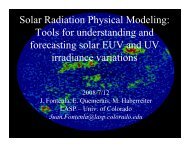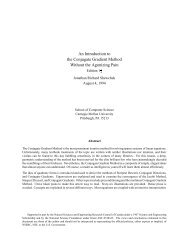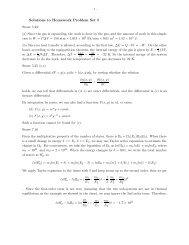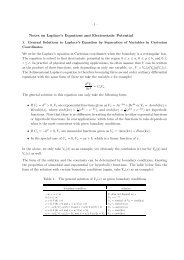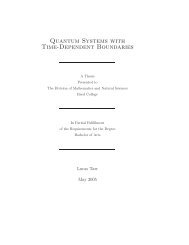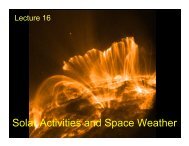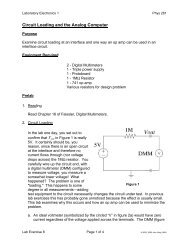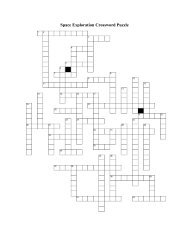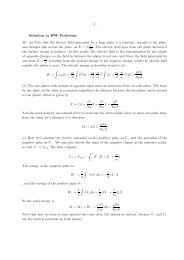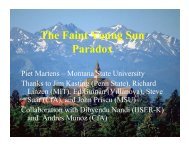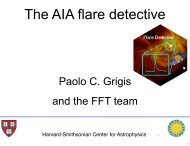312 Lab Manual - Solar Physics at MSU - Montana State University
312 Lab Manual - Solar Physics at MSU - Montana State University
312 Lab Manual - Solar Physics at MSU - Montana State University
Create successful ePaper yourself
Turn your PDF publications into a flip-book with our unique Google optimized e-Paper software.
•M<strong>at</strong>erials<br />
Star Chart <strong>Lab</strong><br />
Star Atlas Deluxe Edition<br />
•Procedure<br />
In this lab, you will explore the star charts of<br />
our night sky. You might want to skim the introduction<br />
<strong>at</strong> the front of the charts before you<br />
begin. In the front or back of the book you’ll<br />
find a transparency which lays over the charts,<br />
giving you more detailed measurements. Star<br />
charts use a special type of coordin<strong>at</strong>es, called<br />
the Equ<strong>at</strong>orial system. If you are not familiar<br />
with this system, e.g. Right Ascension (RA) and<br />
Declin<strong>at</strong>ion (Dec.), then take a minute to read<br />
Appendix A of this manual. Otherwise, answer<br />
the questions below.<br />
•Questions<br />
1)<br />
a. Wh<strong>at</strong> constell<strong>at</strong>ion is the star Alberio in?<br />
b. Wh<strong>at</strong> magnitude star is it?<br />
c. Wh<strong>at</strong> is its RA and Dec.?<br />
d. How far is it (RA, Dec.) from Vega?<br />
2)<br />
a. How many stars in our night sky (seen in the<br />
Northern Hemisphere) have magnitude 0.0 or<br />
brighter?<br />
b. Wh<strong>at</strong> other name does Vega have, based on<br />
the naming scheme developed by Johann Bayer?<br />
The symbol α refers to the brightest star in a<br />
constell<strong>at</strong>ion, β the second brightest, and so<br />
on.<br />
3)<br />
a. Wh<strong>at</strong> is special about the star Betelgeuse?<br />
b. Wh<strong>at</strong> constell<strong>at</strong>ion is it in?<br />
c. Wh<strong>at</strong> famous nebula is also in this constell<strong>at</strong>ion?<br />
4)<br />
a. Wh<strong>at</strong> constell<strong>at</strong>ion is the Andromeda galaxy<br />
in?<br />
b. How many arc minutes wide is it?<br />
5) Name two named stars in the constell<strong>at</strong>ion<br />
Cassiopeia.<br />
6)<br />
a. About how many stars are in the Pleiades<br />
cluster?<br />
b. Why do you think its nick name is “The Seven<br />
Sisters”?<br />
c. Which constell<strong>at</strong>ion is the Pleiades cluster in?<br />
7)<br />
a. Which named star is ten arc minutes from<br />
the brightest star in the constell<strong>at</strong>ion Gemini?<br />
b. Is the brightest “star” in Gemini actually just<br />
one star?<br />
c. Wh<strong>at</strong> type of object lies 38 arc minutes less<br />
in RA, 0.6 o in Dec. south from the star Pollux?<br />
d. Wh<strong>at</strong> type of object lies about 20 arc minuets<br />
less in RA, 1.5 o in Dec. north of Pollux?<br />
8) When looking in the night sky from campus,<br />
you certainly see fewer stars than are on these<br />
maps. Many constell<strong>at</strong>ions are actually easier to<br />
find in conditions such as on campus.<br />
a. Which stars do you think you can see in the<br />
constell<strong>at</strong>ion Lyra from campus?<br />
b. Wh<strong>at</strong> planetary nebula is in Lyra?<br />
c. Describe how you would find the nebula in b.<br />
when looking <strong>at</strong> the night sky through a telescope.<br />
9)<br />
a. Wh<strong>at</strong> do you notice in chart #13 th<strong>at</strong> is interesting?<br />
Hint: look in the constell<strong>at</strong>ion Virgo.<br />
b. Wh<strong>at</strong> do you think is going on here? See chart<br />
B for the answer.<br />
c. How many Messier objects are in this cluster?<br />
10)<br />
a. Name all of the main stars in the constell<strong>at</strong>ion<br />
Ursa Major.<br />
b. With binoculars, you can see th<strong>at</strong> the end<br />
star in the handle is a multiple star. How many<br />
arc minutes apart are the two brightests’ centers?<br />
11) Name four contell<strong>at</strong>ions closest to the north<br />
star.<br />
12)<br />
a. Wh<strong>at</strong> magnitude is the star Kochab?<br />
b. Is it the brightest star in its constell<strong>at</strong>ion? If<br />
not, which star is? How do you know?<br />
13)<br />
a. How many stars with magnitude four or<br />
brighter are visible within 30 arc minutes (RA),<br />
10 o (Dec.) south of the star Mirphak?<br />
Star Chart <strong>Lab</strong><br />
39



